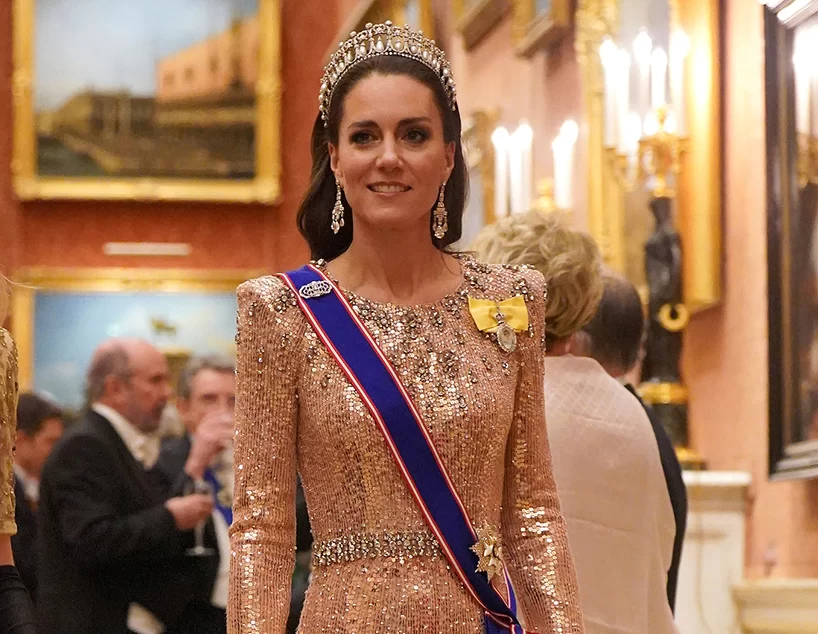The Princess of Wales announced she is receiving cancer treatment amidst intense social media scrutiny

Photo via katemiddletonstyle.org.
On March 22, Princess Catherine of Wales, known to most as Kate Middleton, issued a video announcing that she was diagnosed with cancer and is undergoing “preventative chemotherapy.” In the video, Middleton requested “time, space, and privacy” to process the news and recover. The announcement follows rampant online speculation. Users on social media platforms debated Middleton’s recent absence from public engagements following “planned abdominal surgery.”
According to the Guardian, hashtags such as #whereiskate and #katemiddleton gathered traction on social media, reaching around 2.3 million shares on platforms like Instagram and TikTok. Videos and posts under these tags touted theories about Middleton’s whereabouts including absurd claims that Middleton was the anonymous graffiti artist “Banksy” or recovering from a Brazilian butt lift procedure.
While royal conspiracy theories can be fun and compelling topics for online discussion, the Kate Middleton saga is a case study in how social media can fuel conspiratorial thinking.
In an interview with CBC, assistant professor in communication, pop culture and film at Brock University Michelle Chen said public interest surrounding Middleton is “reminiscent of events that reflect distrust in institutions such as the government and media, a general lack of information, and uncertainty.” In the absence of official updates, speculation and conspiracy theories can spread quickly, especially when they appeal to emotions like anger, fear, or humour.
Kensington Palace exacerbated the situation by releasing an Instagram photo on March 10, showing Middleton with her three children. Observers said uncanny aspects of the image, such as Princess Charlotte’s sleeve, were evidence of alteration. Global media outlets, such as the Associated Press and Reuters, issued “kill notices” on the photo due to “manipulation.” On the Prince and Princess of Wales’ Twitter account, a post from ‘C’ (Kate’s moniker) apologized for the confusion, saying she was “experimenting” with photo editing software.
Notably, before the photo incident, the royals had remained true to their original announcement on Jan. 17, when they announced Middleton had undergone surgery and would be unlikely to return to her duties before Easter.
The doctored image was probably a public relations blunder. However, the photo scandal (known to some as #kategate) may have never occurred without mounting pressure from online commentators and the media on the family to release more news on Middleton’s well-being. As rumours escalated, sinister suggestions that Middleton was in a coma or the victim of a palace cover-up might have spurred the palace to release this image — a move that backfired.
It’s worth remembering that avid scrutiny of royals has had devastating consequences. When Lady Diana Spencer died in a car collision, a jury later ruled that the paparazzi in pursuit of her limousine was partially responsible for the incident alongside the chauffeur. At her funeral, her brother, Charles Spencer, described Diana as the “most hunted person of the modern age,” referencing the intrusive media attention she received throughout her life.
With Diana’s memory in mind, the royals have been part of press reforms in the UK. From 1998 onward, regulations limited the use of long telephoto lenses to capture footage of the royals in their homes or other “private settings.” Social media brings new challenges; as public figures and influences constantly share intimate details of their daily lives, our notions of public and private have become blurred.
However, the expectation that the monarchy discloses their personal health status is a new development. Even during her final months, the late Queen Elizabeth remained stoic on details surrounding her health. King George VI reportedly never knew of his cancer diagnosis; his lung removal surgery was justified to him and the public as “structural abnormalities.”
The British royals are still adjusting to new demands; this year, King Charles decided to deviate from tradition by sharing his prostate cancer diagnosis. Charles’ forthrightness has benefits, such as raising awareness for his condition and the importance of testing. However, Charles decided to share this news himself, whereas Middleton was pressured into releasing diagnostic information.
At the end of February, royal aides released a statement to the Sun newspaper which referred to the “madness of social media” and reiterated the princess’ “right to privacy.” Middleton followed tradition by being reticent, but the public willingness to allow this has seemingly shifted.
Middleton’s video brings the real-life impacts of this into focus: a mother of three has received a devastating diagnosis while contending with voracious public attention. We can hope that Princess Kate will be given the space she needs to heal. Unfortunately, the situation reveals deeper issues within digital culture, where boundaries are ambiguous and misinformation can circulate. Going down the social media rabbit hole may be fun, but everyone, even a princess, deserves privacy.








